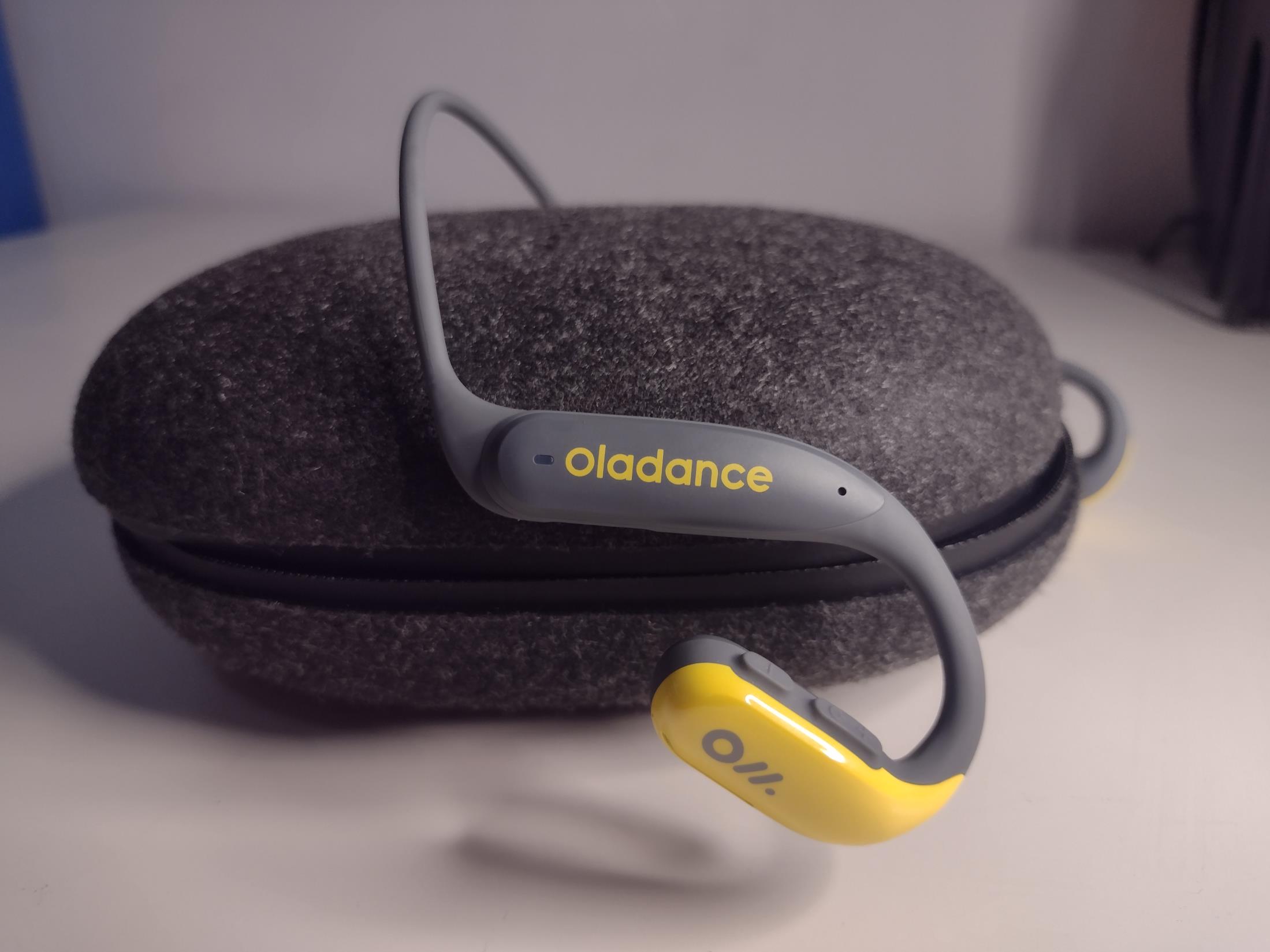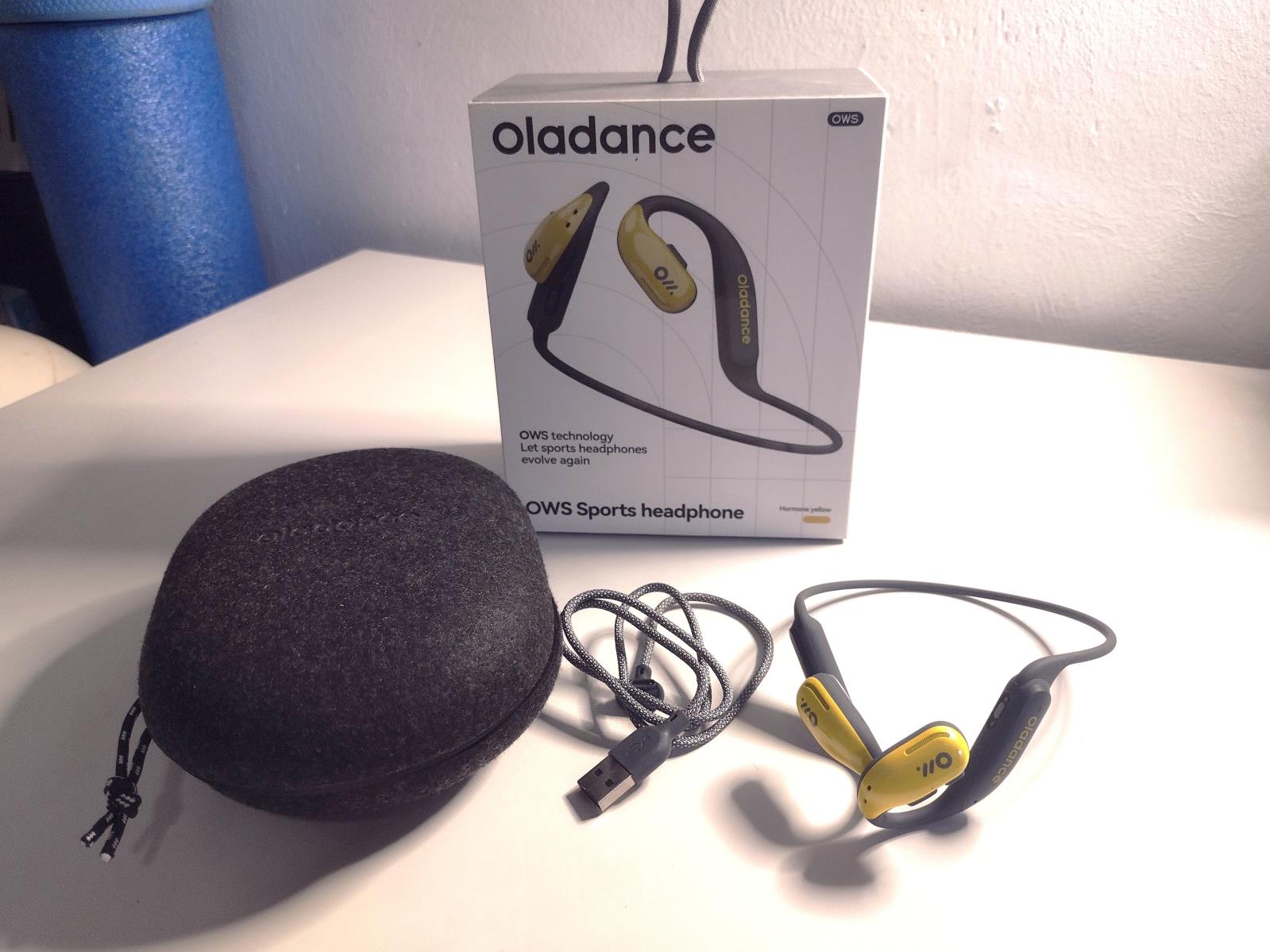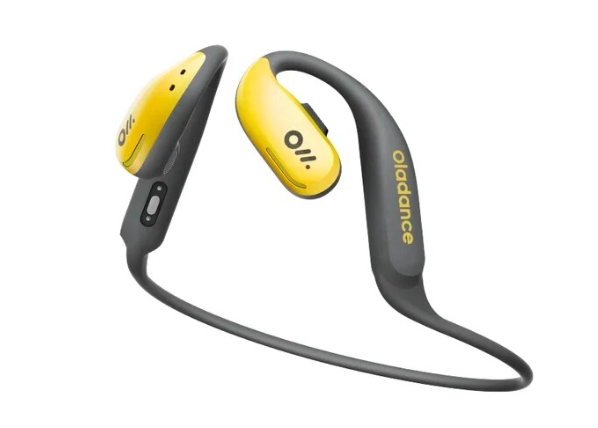Oladance OWS Sports Headphones Review: Open Ear Design for Runners and Triathletes
 Karen Parnell
December 04, 2023
Karen Parnell
December 04, 2023
Oladance OWS Sports Headphones Review: Open Ear Design for Runners and Triathletes
Choosing the right pair of headphones for running and other sports can significantly enhance your exercise experience. Among the various options available, three prominent technologies stand out: bone conduction, noise cancelling, and open ear headphones.
Oladance has focused on open ear technology to help runners listen to music or podcasts in safety and comfort. Their new OWS Sports headphones are stylish and have a great deep sound, so I was excited to try them out for myself. I used to work for a company called CSR who made Bluetooth chips and I was responsible for the product marketing of their headset products so have tried many headphones in my time. I was interested to see how that stacked up against the ones I used to test back then.
In this article, we will look at the differences between these technologies and explore why open ear headphones may be the ideal choice for runners. We will also look at what makes the Oladance OWS Sports Earphone a good choice for runners and triathletes.
Types of Headphones
Before we look at the OWS Sports Earphones lets appreciate the three main headphone types.
- Bone Conduction Technology
Bone conduction headphones transmit sound through the bones of the skull rather than through the ear canal. This unique approach allows runners to remain aware of their surroundings while enjoying music or taking calls. Bone conduction technology is particularly appealing for safety-conscious individuals who want to maintain situational awareness during outdoor activities.
However, some users may find that the audio quality is not as rich as traditional headphones, and they may not be suitable for those who prefer immersive sound experiences. Bone Conduction headphones may also hag your head to conduct through your head so may be tight and a bit uncomfortable if worn for a long time.
- Noise Cancelling Technology
Noise cancelling headphones use sophisticated technology to reduce or eliminate external sounds. This is achieved through active noise cancellation (ANC), where microphones pick up ambient sounds and generate sound waves that cancel them out. While noise cancelling headphones provide an immersive audio experience, they may not be the best choice for runners.
The effectiveness of ANC relies heavily on the seal of the ear cups, which can isolate the runner from their environment. For outdoor activities like running, being aware of your surroundings is crucial for safety.
- Open Ear Headphones
Open ear headphones allow ambient sounds to reach the ears while delivering audio. Unlike traditional headphones, these rest on the outer ear, leaving the ear canal open. This design enables runners to enjoy their favourite tunes while remaining attuned to traffic, conversations, or other potential hazards.
The open ear design also helps prevent the discomfort associated with prolonged use of in-ear, over-ear, or bone conduction headphones. Runners can enjoy their music without compromising their awareness of the surrounding environment.
Why Open Ear May Be Better for Runners
a. Safety First
- Maintaining awareness of your surroundings is crucial for outdoor activities.
- Open ear headphones allow runners to hear approaching vehicles, pedestrians, or other potential hazards.
b. Comfort and Breathability
- Traditional headphones can cause discomfort and sweating during extended use.
- Open ear designs provide a comfortable fit and allow for better airflow, reducing the risk of irritation.
c. Versatility
- Open ear headphones are not limited to running; they can be suitable for various activities like cycling, hiking, or commuting.
d. Staying Connected
- Open ear headphones often come equipped with features like built-in microphones, enabling runners to take calls without removing their headphones.

Oladance OWS Sports headphones and plush hard case
The Oladance OWS Sports Headphones In Depth Review
When choosing headphones for sporting activities like running there are certain things that are non-negotiable namely great audio quality, comfort, sweat proofing and long battery life. Will the olandance headphones meet these non-negotiables?
Audio Quality
OWS means Open Wearable Stereo and the concept was realised by the former Research and Design team from Bose who know a thing or two about audio. They chose the latest Qualcomm chips to deliver advanced audio and Bluetooth functionality (Qualcomm acquired CSR in 2014).
They use aptX audio to deliver 24-bit music quality over Bluetooth. This means listeners can hear even the smallest details in their music.
What does this mean to the runner? A better sound with more Bass, richer sound and high notes.
They have also added in wind noise reduction so when you are running in windy conditions you can hear your favourite tunes.
Taking phone calls on your OWS Sport headphones is also a pleasure thanks to their dual microphones for precise sound capture and an intelligent noise reduction algorithm, it eliminates background noise during your calls. Even at wind speeds of 2-3m/s, every word you speak is transmitted clearly to the other person.
Comfort and Safety
The open ear design of the Oladance OWS sports headphones means that they don’t go into your ear canal but sit slightly above it and pipe music into your ear. OWS means Open Wearable Stereo and the concept was realised by the former. The team at OWS made theses sports headphones lightweight and focussing on flexibility and comfort and not clamping your head like bone conduction headphones can tend to do.
One of the biggest advantages of open ear headphones is that they enable you to stay aware of your surroundings and safe while exercising – health and safety go hand in hand. OWS Sports keeps you connected to your environment, be it cars, nearby cyclists, or other warning sounds which gives you extra security during exercise. I find this particularly useful when I go from running quiet trails and return to urban areas when you need to be aware of cars etc.
I’ve used these headphones trail running, hiking, indoor rowing and weight training and they stay put throughout the workouts.
Sweat and Water Proof
The OWS Sport is waterproof and ready for action with an impressive IPX8 waterproof level. Rain, shine, sweat or a surprise splash, they are built to endure whatever the weather throws at you during your sports activities or sweat on your indoor turbo trainer.
If you trail run like me and sometimes get muddy you can clean these by running them under a tap for a few seconds without worry.
You can’t swim with these headphones however, but they guys at OWS say they are working on this so watch this space.
Battery Life
Up to 15 hours from a single charge of 2 hours which is around double that of some bone conduction headphones. The long battery life should last long enough for even an ultra-marathon!
The charge cable is magnetic which is easy to connect.
They can give you 5 hours off playback off a 15-minute charge and have a crazy standby time of three years!
Packaging
There are two aspects to the OWS headphones when it comes to packaging. Firstly, when you first open the box, you notice the soft, plush, stylish case which says quality. Inside the case is a cabinet with magnetic clasp holding the charge cable.
The cases is large enough to store extra bits and pieces which I took advantage of on my recent self-supported walk of the famous Senda Litoral seaside path in the Costa del Sol. I had to pack light but wanted to take my Oladance OWS headphones with me. I was able to use the case to carry the headphones, headphone charge cable and also my phone and Coros watch cables as well plus some headbands in there as well! All in all a very practical case.
Then there’s the headphones outer packaging which feels robust but stylish with positive buttons and rubber that is kind to your skin.

The oladance OWS sports headphones, plush case, charge cable and outer packaging
Usability
The buttons are physical buttons and very positive so no accidental button presses. Here’s how they work:
In music mode
- Press once: Play/Pause
- Press twice: Play the next song
- Press three times: Replay the previous song
In call mode:
- Press once: Answer phone
- Press twice: Hang up/Reject call
Wake up voice assistant
- Press and hold for 0.5 second
The headphones have multipoint connectivity so you can connect to two devices at the same time as your phone and your computer, so you don’t need to muck about with pairing and reconnecting when you go from music playback to going on a Zoom call for example.
There is an Oladance App on which you can switch between 4 sound modes to customize your unique listening experience.
Apart from physical buttons on the earphones, they also offer the OWS Button as an add-on to efficiently manage your music and phone calls with ease while you are cycling, climbing, or skiing. In music mode, a single press controls music playback/pause. In call mode, a single press answers/ends the call. I did not get to try this, but it could be useful when using your headphones on your indoor bike as you can mount the button on your handlebars.
Wearability
Long Hair
When I saw the media photos all of the people wearing there headphone had short hair so I was interested to see how they worked with long hair. I am pleased to report I could wear them with my hair up in a ponytail and also down without problem. My personal preference is with a ponytail for running etc. They worked even with my small ears!
They stayed in position when running, hiking, indoor cycling and when working out at the gym.
Glasses
I wear glasses when I work so tried them with my glasses on and there were no problems.
Crowd Funding
If you like the sound (excuse the pun) of these headphones you can get in early with a 35% lower price via their crowd funding campaign on KickStarter. This means a price of $129 instead of the usual $199.
Conclusion: Oladance headphones
Choosing the right headphones for running and other workouts involves considering your priorities: sound quality, safety, comfort, and versatility. While bone conduction and noise cancelling headphones offer unique benefits, open ear headphones strike a balance by allowing runners to enjoy their music while staying connected to their environment.
The Oladance OWS Sports headphones offer you great audio quality, comfort, waterproof confidence, Bluetooth handsfree capability for audio and calls, best in class battery life all packaged in a top-quality hard case.
Open ear headphones appear to be a promising choice for those who prioritize safety and comfort during their workouts and have been a revelation for me when I’m running the trails and training indoors.
Oladance OWS Sport Headphones unboxing video
Karen Parnell is a Level 3 British Triathlon and IRONMAN Certified Coach, 8020 Endurance Certified Coach, WOWSA Level 3 open water swimming coach and NASM Personal Trainer and Sports Technology Writer.
Karen is currently studying for an MSc in Sports Performance Coaching at the University of Stirling.
Need a training plan? I have plans on TrainingPeaks and FinalSurge:
I also coach a very small number of athletes one to one for all triathlon and multi-sport distances, open water swimming events and running races, email me for details and availability. Karen.parnell@chilitri.com
Get your FREE Guide to Running Speed and Technique
Get your FREE Swim Workouts for Triathletes E-book
Get your FREE Open Water Swimming Sessions E-Book
Get you FREE 31 Structured Indoor Cycling Sessions and Training Plan
FAQ: Oladance and Sports Headphones
Q1: What are the main differences between bone conduction, noise cancelling, and open ear headphones?
Bone conduction headphones transmit sound through the bones of the skull, leaving the ear canal open. Noise cancelling headphones use active technology to reduce or eliminate external sounds by generating sound waves that cancel them out. Open ear headphones, also known as bone conduction or open-ear designs, rest on the outer ear, allowing ambient sounds to reach the ears while delivering audio.
Q2: Why might noise cancelling headphones not be the best choice for runners?
Noise cancelling headphones rely on creating a seal around the ears to effectively block external sounds. For runners, maintaining awareness of the surroundings is crucial for safety. The isolation provided by noise cancelling headphones can pose a risk by limiting the ability to hear approaching vehicles or other potential hazards.
Q3: What advantages do bone conduction headphones offer for runners?
Bone conduction headphones allow runners to enjoy music or take calls while maintaining situational awareness. Since they don't cover the ears, users can hear external sounds, making them a safer choice for outdoor activities.
Q4: Why are open ear headphones considered suitable for runners?
Open ear headphones, with their unique design, allow ambient sounds to reach the ears while delivering audio. This enables runners to stay aware of their surroundings, such as traffic or conversations. Additionally, open ear headphones are often more comfortable and breathable than traditional designs.
Q5: Can open ear headphones be used for activities other than running?
Yes, open ear headphones are versatile and can be suitable for various activities such as cycling, hiking, or commuting. Their design allows for comfort and awareness in a range of environments.
Q6: Do open ear headphones compromise on sound quality?
While open ear headphones may not provide the same level of sound isolation as traditional headphones, advancements in technology have improved their audio quality. Users can enjoy a balanced audio experience without completely blocking external sounds.
Q7: Are open ear headphones equipped with additional features for convenience?
Yes, many open ear headphones come with features like built-in microphones, allowing runners to take calls without removing their headphones. This added convenience enhances the overall experience for users who prioritize staying connected during their activities.
Q8: Are open ear headphones comfortable for extended use?
Yes, open ear headphones are designed to be comfortable for prolonged use. Unlike in-ear or over-ear headphones that can cause discomfort and sweating, the open ear design allows for better airflow, reducing the risk of irritation during extended workouts.
Q9: Can open ear headphones withstand outdoor conditions?
Many open ear headphones are designed with water and sweat resistance, making them suitable for outdoor activities. However, it's essential to check the product specifications for specific details on durability and resistance features.
Q10: What factors should I consider when choosing headphones for running?
Consider factors such as safety, comfort, sound quality, battery life, sweat proofing, and versatility. For runners, prioritizing headphones that allow you to stay aware of your surroundings, provide comfort during extended use, and offer a balanced audio experience is key. Open ear headphones often strike a good balance among these factors.
When you buy something we recommend, we may get an affiliate commission — but it never affects your price or what we pick.

